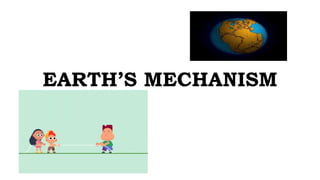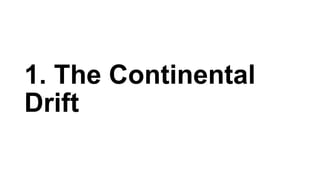EARTH'S MECHANISM.pptx
- 2. THEORIES OF THE EARTH’S MOVEMENT
- 4. In 1912, Alfred Wegener (pronounced as vey-guh- nuh r), a German meteorologist, proposed a theory that about 200 million years ago, the continents were once one large landmass. He called this landmass Pangaea, a Greek word which means “All Earth.”
- 5. This Pangaea started to break into two smaller supercontinent called Laurasia and Gondwanaland during the Jurassic Period. These smaller supercontinents broke into the continents and these continents separated and drifted apart since then.
- 8. The Seafloor Spreading Theory According to this theory, hot, less dense material from below the earth’s crust rises towards the surface at the mid-ocean ridge. This material flows sideways carrying the seafloor away from the ridge, and creates a crack in the crust. The magma flows out of the crack, cools down and becomes the new seafloor.
- 9. The Earth’s whole lithosphere is broken into several rigid sections called plates that move constantly.
- 10. GUESS THE WORD
- 11. tmnael • a layer beneath where the less dense hot molten material rises and sinks
- 12. thprehaeosens a soft, weak and plastic-like layer, upper part of the mantle where lithospheric plates float and move.
- 13. mmgaa hot molten rocks formed beneath the Earth’s surface.
- 14. noitcevnoc ctunrre facilitates the movement of the lithospheric plates
- 15. orce innermost layer of the earth which generates heat to the mantle
- 16. Plate Tectonic Theory • Plate tectonic Theory was developed in 1960s, stating that the Earth’s lithosphere-the crust and the upper mantle- is broken up into a several pieces called plates that move slowly.
- 17. It explains how the massive plates move along the different types of plate tectonic boundaries (convergent, divergent and transform fault) where they interact, and the geologic events (earthquakes and subduction) and geologic features (formation of mountains, volcanoes and trenches) that occur at their boundaries.
- 18. What Makes Lithospheric Plates Move?
- 19. HEAT TRANSFER
- 21. •A convection current is a heat transfer process that involves the movement of energy from one place to another.
- 22. The convection currents tend to move a fluid, gas particles, or molten rock. These are due to the differences in the densities and the temperature of a specific gas or a fluid. Due to this temperature difference, the hot fluid tends to rise as it expands, whereas cold fluid tends to sink because it contracts.
- 23. Convection current also happens in the mantle. The mantle is the second inner layer of Earth, made up of mostly hot rocks and magma. It is a very hot layer because of the heat generated by the core. The source of heat from the core is due to the decay or breakdown of radioactive elements. Mantle convection is a process by which a thermal convection occurs in the inner layer of the earth. The differences of the temperature at the Earth’s interior and surface cause convection currents to occur within the mantle.
- 24. Lithospheric plates are the parts of the uppermost layer of the Earth and they are flowing in an area called asthenosphere. Asthenosphere is a soft, less rigid upper part of the mantle where the lithospheric plates float and move with around.
- 25. Plates move slowly and constantly when the hot less dense material rises. The rising hot material cools down in a certain area so it becomes denser than the cool dense material sinks, that creates convection cell, with hot rising currents and cool sinking currents are regularly repeated and become a cycle.
- 26. The movement of lithospheric plate is attributed to mantle convection and considered as one of the driving mechanisms for plate motion. Lithosphere at divergent boundary will uplift and tear apart due to the rising of hot magma. The sinking of magma pulls down the tectonic plate at convergent boundary. Aside from mantle convection, ridge push, sliding, and slab pull are other forces that move the lithospheric plates.
- 27. •In the process of slab pull, the presence of a heavier subducting plate pulls down the trailing slab into the subduction zone. • In a ridge push or gravitational sliding process, the old oceanic crust becomes heavier than the new oceanic crust and sinks because of the weight of the raised ridge which pushes down the older oceanic crust towards the trench at the subduction zone.
- 29. LET’S ASSESS! 1. What are the theories that explain plate movement? 2. What are the three types of heat transfer? 3. How does convection current or mantle convection work? 4. What are the mechanisms that cause the lithospheric plate to move?
- 30. • Arrange the following events in the mantle convection process. Use numbers 1-5. ____a. Lithospheric plates move in the asthenosphere due to rising and sinking of materials. ____b. The decomposition of radioactive elements causes heat in the interior part of the Earth. ____c. Heat slowly rises to the mantle and creates convection current. ____d. Heat moves to the core. ____e. The process repeats as cycle.





























